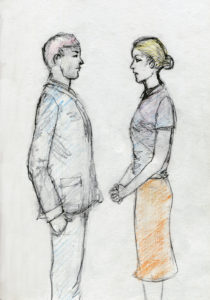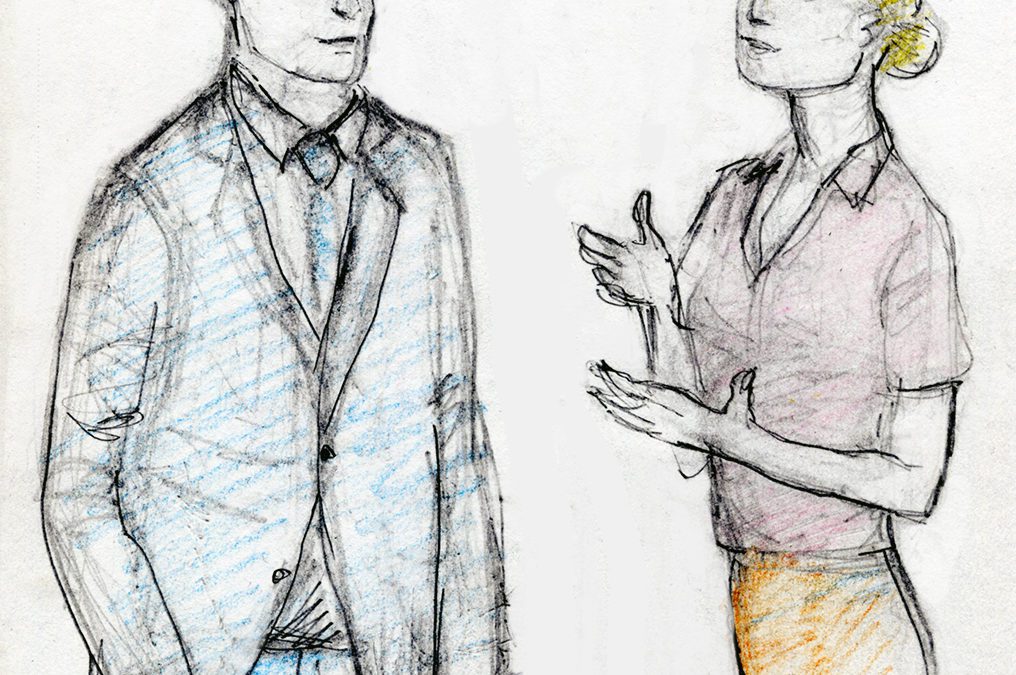If you are a leader or in sales, you’ll want to know this gender difference!
When communication is important, you’ll want to know how to apply this gender difference. New neuroscience research has found that humans can pass extremely specific behaviors from one generation to the next through an encoding system. This helps explain the findings in an experiment published many years ago regarding the gender difference between males and females.
Here’s the punchline. If a woman is directly in front of and pointed at a man and begins nearing his personal space, his subconscious mind will likely interpret it as either a potential physical assault or a sexual come-on!
If you’re leading, managing others, selling, or even trying to have a good conversation with a teenager, being aware of your body’s angle can create connection, or anxiety, for the person you’re communicating with, depending on your and the other person’s gender.
After you watch the video, or read the transcript, do your own experiment with a good friend or colleague (but not someone you hug regularly). You’ll be convinced.

In the first image, the man will be very uncomfortable! In the second image, the man can relax. Do you know why? Join speaker agent Kim Tracy and me by either watching the video or reading the edited text below to learn why. It’s a critical gender difference in communicating — male to male, female to male, or female to female.
[vc_video link=”https://youtu.be/BGdRuqHk3xE”]
Kim: Hi, I’m Kim Tracy with the Maxwell James Speaker Agency here with Dr. TC North. Today’s topic is really good! I don’t know if I buy this or not, but he wants to talk about the gender difference no one seems to know about. And TC is saying that men are perceiving subconsciously that we women are either physically threatening or sexually advancing on men in ways that we are not aware of.
TC: You got it, ma’am!
Kim: Take it away. Good luck!
TC: I’ve been talking about this for over 30 years now, and I’ve not run into anybody yet who has heard this. It always just stuns me. Background: I read a piece of research in the beginning of my career, about 30 years ago. I’ve been looking for it the past couple of years, and I’ve never been able to find it again. So if anybody knows this research who’s watching this video (or reading the transcription), please send me the link! I really want to be able to reference this research.
The research was done at Denver University, and the setup was the researchers brought two same-gender school-age children into a room. The experimenters wanted to see what these kids would do, just left in the room by themselves with nothing.
The kids were told that the experimenters forgot to bring the stuff that the kids were going to play with. So the experimenters brought the pairs in, two boys then two girls, at different times and left them in the room with no adults and cameras rolling to see what the pairs of kids would do. Here’s what happened, Kim: It was significantly different between the two girls and two boys. I’ll see if you can guess this. If you leave two school-age girls together in a room, what do you think they end up doing after a couple of minutes?
Kim: They’re either going to gossip or they’re going to fight. Ha!
TC: I’m going to be very careful what I say next. What they did — these two girls would end up touching, knees touching, playing with each other’s hair and stuff, totally face to face. What do you think the two boys ended up doing? The two boys did interact, but they were never face to face. They were both sitting against the wall, shoulder to shoulder, with about 6 inches between them. But they were talking. So completely different style of communication and interaction.
The conclusion was — and they went deep into the DNA science behind this — if you think of male history, we are hunters and warriors. It’s deep in our DNA, and we’re now finding through genetic research that DNA gets passed on through generations. If I was a hunter for many generations, I still have that in my DNA even though I’m not a hunter. The reason why boys are shoulder to shoulder is that’s how we go to war, that’s how we hunt, that’s our DNA. Women are more the nurturers, lovers, communicators, caretakers of family and the community. So they’re out there touching and being big-hearted people.
So what happens when a woman treats a man like a woman and approaches a man like a woman? If you and I are together and you come into my space, face to face, full body on, my DNA, my subconscious says you’re either about to attack me or [it’s] a sexual come-on. Not a great thing, especially in the business world! Women, if you want to have a good discussion with a guy, go out and walk with them, go out and be in an open environment (that’s helpful in itself). Because when you’re walking, you’re shoulder to shoulder.
One of my favorite clients, his right-hand guy says, “I love my windshield time with Tom,” (name changed) because when they’re driving, and they have to take some long road trips together, Tom always drives and his right-hand guy is the passenger. He says it’s great because that’s when they have in-depth conversations. Think of their body positions. They’re not looking at each other, and they’re shoulder to shoulder. There’s no threat there, and so men actually go deeper sometimes that way and women get crazy because that’s the opposite of how women go deep. Whether it’s in a marriage relationship or anything, it’s really important to keep that body position in mind of how you want to communicate, how you want to interact.
Kim: So I have a question for you. We are doing this video by Zoom, so you guys as the viewer are actually just seeing me, but as we’re recording, TC and I can see each other. So in this scenario, you are not threatened by me because I’m not coming into your personal space.
TC: No. And funny that you mention it, because I wouldn’t have thought about it. But I actually have you going off my left shoulder. So I don’t have you eyeball to eyeball, face to face. As a coach, and I used to be a therapist many years ago, I learned with all of my clients, male and female, to be face to face with them. But my body is never directly on; it’s always turned just a little bit so that if someone is angry or upset, I don’t take on that energy. I want them to be able to express that energy, but I don’t want it hitting directly on my body. So I turn my body slightly, still face to face, eyeball to eyeball, but not body to body.
Kim: OK, so what I’m hearing, to do active listening, is that as a woman in a business environment, we need to be very cognitive of not only our body position but also what’s going on DNA-wise with a man.
TC: Yeah, absolutely. So with salespeople, the best way to sit is catty-corner. Shoulder to shoulder is a little strange unless you’re working on a document. Then it can work because you’re on the same side of the table. If you’re going to lunch, you’re sitting in an office, just sit catty-corner and then you’re not threatening. You can be close (but don’t let a knee touch, don’t let a leg touch, because that changes everything).
Kim: Wait a minute, the first time we met … no, I’m just kidding!
TC: I enjoyed you rubbing my knee. No, I’m just kidding — all kidding!
Kim: We’re just kidding.
TC: We shouldn’t go off script.
Kim: Hey, you guys. He also was injured, so he had to have his right leg propped up on a chair.
TC: That’s true, I was showing some leg, wasn’t I?
Kim: You were! And the cowboy boots too!
So this is actually really important when you’re in sales, but also let’s say a three- or four-person meeting. Not only does it matter how you position yourself at the table, but what is your body language saying?
TC: The most famous of all examples is the knights at the round table. The knights at the round table were all shoulder to shoulder, catty-corner. No one had dominance, no one had anything — it was all equal. That was the first time anyone figured out the use of this concept.
Kim: Excellent. Any other tips for the viewers today?
TC: I think that’s enough. I think just be really aware that body language has many pieces. Today we’re talking about a male-female gender difference and how to interact the body languages so that people can trust and be comfortable, especially in a male-female situation.
TC: Thank you.



